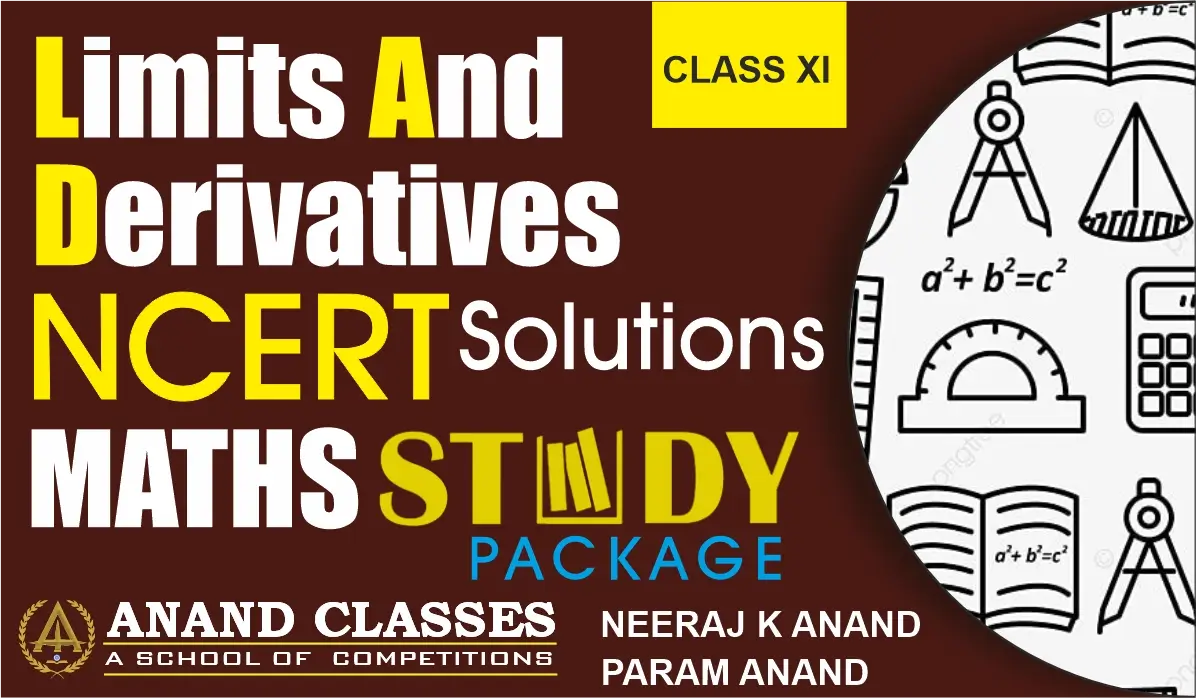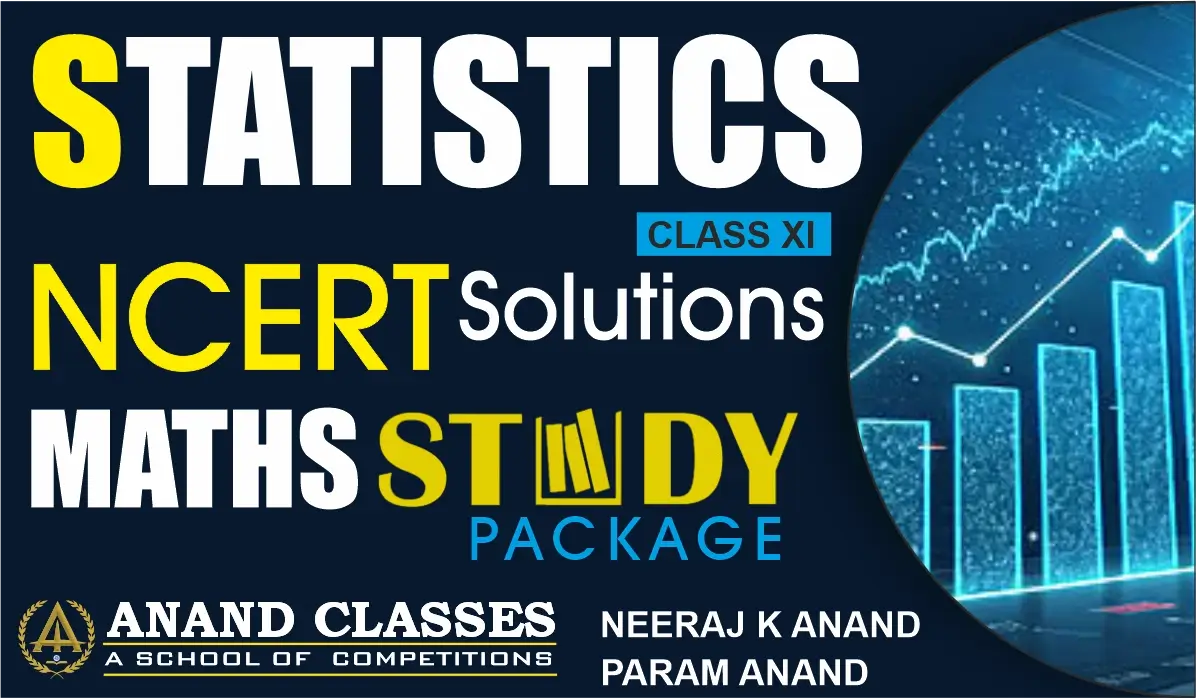Anand Classes provides advanced-level NCERT Solutions for Class 11 Maths Chapter 12 Limits and Derivatives Exercise 12.1 (Set-3) to help students practice a wider range of limit problems and strengthen their calculus foundation. These step-by-step solutions are created according to the latest CBSE and NCERT syllabus, offering clear explanations, logical steps, and solved examples for deeper conceptual understanding. This third set is ideal for revision and self-assessment before exams. Click the print button to download study material and notes.
NCERT Question 21 : Evaluate
$$\lim_{x\to 0}\big(\csc x – \cot x\big)$$
Solution:
In
$$\lim_{x\to 0}\big(\csc x – \cot x\big)$$
By simplification, we get
$$
\lim_{x\to 0}\left(\frac{1}{\sin x}-\frac{\cos x}{\sin x}\right)
$$
$$
\lim_{x\to 0}\left(\frac{1-\cos x}{\sin x}\right)
$$
Put $x=0$, we get
$$
\lim_{x\to 0}\left(\frac{1-\cos x}{\sin x}\right)=\frac{0}{0}
$$
As, this limit becomes undefined.
Now, let’s simplify the equation to make it equivalent to the theorem:
$$
\lim_{u\to 0}\frac{\sin u}{u}=1.
$$
By using trigonometric identities,
$$\cos 2\theta = 1-2\sin^2\theta,\qquad \sin 2\theta = 2\sin\theta\cos\theta.$$
Hence, we can write the equation as follows:
$$
\lim_{x\to 0}\frac{1-\cos x}{\sin x}
= \lim_{x\to 0}\frac{2\sin^2\left(\tfrac{x}{2}\right)}{\sin x}.
$$
Using $\sin x = 2\sin\left(\tfrac{x}{2}\right)\cos\left(\tfrac{x}{2}\right)$, this becomes
$$
\lim_{x\to 0}\frac{2\sin^2\left(\tfrac{x}{2}\right)}{2\sin\left(\tfrac{x}{2}\right)\cos\left(\tfrac{x}{2}\right)}
= \lim_{x\to 0}\frac{\sin\left(\tfrac{x}{2}\right)}{\cos\left(\tfrac{x}{2}\right)}
= \lim_{x\to 0}\tan\left(\frac{x}{2}\right).
$$
Putting $x=0$, we have
$$
\lim_{x\to 0}\tan\left(\frac{x}{2}\right)=0.
$$
Final Answer
$$
\boxed{0}
$$
NCERT Question 22 : Evaluate
$$\lim_{x\to \frac{\pi}{2}} \frac{\tan 2x}{x-\frac{\pi}{2}}$$
Solution:
In
$$\lim_{x\to \frac{\pi}{2}} \frac{\tan 2x}{x-\frac{\pi}{2}},\quad \text{as }x\to \frac{\pi}{2}$$
Put $x=\dfrac{\pi}{2}$, we get the indeterminate form
$$\frac{0}{0}.$$
Now set
$$p = x – \frac{\pi}{2},$$
so $x = p + \dfrac{\pi}{2}$ and $p\to 0$ as $x\to \dfrac{\pi}{2}$. Hence
$$
\lim_{x\to \frac{\pi}{2}} \frac{\tan 2x}{x-\frac{\pi}{2}}
= \lim_{p\to 0} \frac{\tan\big(2(p+\tfrac{\pi}{2})\big)}{p}
= \lim_{p\to 0} \frac{\tan(2p+\pi)}{p}.
$$
Using $\tan(\theta+\pi)=\tan\theta$, this becomes
$$
\lim_{p\to 0} \frac{\tan 2p}{p}
= \lim_{p\to 0}\frac{\sin 2p}{p\cos 2p}.
$$
Rewrite to use the standard limit $\displaystyle\lim_{u\to 0}\frac{\sin u}{u}=1$:
$$
\frac{\sin 2p}{p\cos 2p}
= 2\cdot\frac{\sin 2p}{2p}\cdot\frac{1}{\cos 2p}.
$$
As $p\to 0$, $\dfrac{\sin 2p}{2p}\to 1$ and $\cos 2p\to 1$, so
$$
\lim_{p\to 0}\frac{\tan 2p}{p}
= 2\cdot 1\cdot 1
= 2.
$$
Final Answer
$$
\boxed{2}
$$
NCERT Question 23 : Find
$\lim_{x\to 0} f(x)$ and $\lim_{x\to 1} f(x)$, where
$$
f(x) =
\begin{cases}
2x + 3, & x \le 0 \\
3(x + 1), & x > 0
\end{cases}
$$
Solution :
Case.1 :
When $x \to 0$
Left-hand limit:
$$
\lim_{x\to 0^-} f(x) = \lim_{x\to 0^-} (2x + 3) = 2(0) + 3 = 3
$$
Right-hand limit:
$$
\lim_{x\to 0^+} f(x) = \lim_{x\to 0^+} 3(x + 1) = 3(0 + 1) = 3
$$
Therefore:
$$
\lim_{x\to 0} f(x) = 3
$$
Hence,
$$
\lim_{x\to 0^-} f(x) = \lim_{x\to 0} f(x) = \lim_{x\to 0^+} f(x) = 3
$$
So the limit exists and equals 3.
Case.2 :
When $x \to 1$
Since $x = 1 > 0$, the function branch used is $f(x) = 3(x + 1)$.
Left-hand limit:
$$
\lim_{x\to 1^-} f(x) = \lim_{x\to 1^-} 3(x + 1) = 3(1 + 1) = 6
$$
Right-hand limit:
$$
\lim_{x\to 1^+} f(x) = \lim_{x\to 1^+} 3(x + 1) = 3(1 + 1) = 6
$$
Therefore:
$$
\lim_{x\to 1} f(x) = 6
$$
Hence,
$$
\lim_{x\to 1^-} f(x) = \lim_{x\to 1} f(x) = \lim_{x\to 1^+} f(x) = 6
$$
So the limit exists and equals 6.
Final Answers
$$
\boxed{
\lim_{x\to 0} f(x) = 3
\quad\text{and}\quad
\lim_{x\to 1} f(x) = 6
}
$$
NCERT Question 24 : Find $\lim_{x \to 1} f(x),$ where
$$
f(x) =
\begin{cases}
x^2 – 1, & x \le 1 \\
-x^2 – 1, & x > 1
\end{cases}
$$
Solution:
Let’s calculate the limits when $x \to 1$.
Left-hand limit:
$$
\lim_{x \to 1^-} f(x)
= \lim_{x \to 1^-} (x^2 – 1)
= 1^2 – 1 = 0
$$
Right-hand limit:
$$
\lim_{x \to 1^+} f(x)
= \lim_{x \to 1^+} (-x^2 – 1)
= -1^2 – 1 = -2
$$
Since,
$$
\lim_{x \to 1^-} f(x) \ne \lim_{x \to 1^+} f(x)
$$
Final Answer:
Hence, the limit does not exist when $x \to 1$.
$$
\boxed{\text{Limit does not exist.}}
$$
NCERT Question 25: Evaluate $\lim_{x \to 0} f(x)$, where
$$
f(x) =
\begin{cases}
\dfrac{|x|}{x}, & x \ne 0 \\
0, & x = 0
\end{cases}
$$
Solution:
Let’s calculate the limits as $x \to 0$.
We know that the modulus (absolute value) function behaves differently on either side of zero.
In $|x|$, we have:
- $|x| = x$ when $x > 0$
- $|x| = -x$ when $x < 0$
Left-hand limit (LHL):
$$
\lim_{x \to 0^-} f(x) = \lim_{x \to 0^-} \dfrac{|x|}{x}
$$
For $x < 0$, $|x| = -x$, hence
$$
\lim_{x \to 0^-} f(x) = \lim_{x \to 0^-} \dfrac{-x}{x} = -1
$$
Right-hand limit (RHL):
$$
\lim_{x \to 0^+} f(x) = \lim_{x \to 0^+} \dfrac{|x|}{x}
$$
For $x > 0$, $|x| = x$, hence
$$
\lim_{x \to 0^+} f(x) = \lim_{x \to 0^+} \dfrac{x}{x} = 1
$$
Since
$$
\lim_{x \to 0^-} f(x) \ne \lim_{x \to 0^+} f(x),
$$
the limit does not exist as $x \to 0$.
✅ Final Answer:
$$
\boxed{\text{Limit does not exist.}}
$$
NCERT Question 27: Find $\displaystyle \lim_{x \to 5} f(x)$, where $f(x) = |x| – 5$.
Solution:
Let’s calculate the limits when $x \to 5$.
As we know, the modulus (or absolute value) function works differently:
$$
|x| =
\begin{cases}
x, & x > 0 \\
-x, & x < 0
\end{cases}
$$
Since $x = 5$ is positive, we have $|x| = x$ in the neighborhood of $x = 5$.
Left-hand limit:
$$
\lim_{x \to 5^-} f(x)
= \lim_{x \to 5^-} (|x| – 5)
= \lim_{x \to 5^-} (x – 5)
= 5 – 5
= 0
$$
Right-hand limit:
$$
\lim_{x \to 5^+} f(x)
= \lim_{x \to 5^+} (|x| – 5)
= \lim_{x \to 5^+} (x – 5)
= 5 – 5
= 0
$$
Since both left-hand and right-hand limits are equal,
we get:
$$
\lim_{x \to 5^-} f(x)
= \lim_{x \to 5} f(x)
= \lim_{x \to 5^+} f(x)
= 0
$$
Hence, the limit exists and
$$
\boxed{\lim_{x \to 5} f(x) = 0}
$$
✅ Final Answer: $\displaystyle \lim_{x \to 5} f(x) = 0$
Explore more: Strengthen your understanding of modulus limits and continuity with expertly crafted study notes by Anand Classes — ideal for students preparing for CBSE and JEE exams.
Question 28: Suppose
$$
f(x) =
\begin{cases}
a + bx, & x < 1 \\
4, & x = 1 \\
b – ax, & x > 1
\end{cases}
$$
and if $\displaystyle \lim_{x \to 1} f(x) = f(1)$, find the possible values of $a$ and $b$.
Solution:
It is given that the function is continuous at $x = 1$, i.e.
$$
\lim_{x \to 1} f(x) = f(1)
$$
Left-hand limit:
$$
\lim_{x \to 1^-} f(x)
= \lim_{x \to 1^-} (a + bx)
= a + b(1)
= a + b
$$
Right-hand limit:
$$
\lim_{x \to 1^+} f(x)
= \lim_{x \to 1^+} (b – ax)
= b – a(1)
= b – a
$$
And given:
$$
f(1) = 4
$$
For the function to be continuous at $x = 1$, we must have
$$
\lim_{x \to 1^-} f(x) = \lim_{x \to 1^+} f(x) = f(1)
$$
Thus,
$$
a + b = 4 \quad \text{and} \quad b – a = 4
$$
Solving the equations:
Adding both,
$$
(a + b) + (b – a) = 4 + 4
$$
$$
2b = 8 \implies b = 4
$$
Substituting $b = 4$ into $a + b = 4$, we get
$$
a + 4 = 4 \implies a = 0
$$
✅ Final Answer:
$$
\boxed{a = 0, \quad b = 4}
$$
Enhance your learning: Practice more continuity and limit problems with Anand Classes’ expertly prepared materials — ideal for CBSE and JEE aspirants seeking crystal-clear conceptual understanding.
NCERT Question 29 : Let $a_1, a_2, \ldots, a_n$ be fixed real numbers and define a function
$$
f(x) = (x – a_1)(x – a_2) \ldots (x – a_n)
$$
What is $\displaystyle \lim_{x \to a_1} f(x)$?
For some $a \ne a_1, a_2, \ldots, a_n$, compute $\displaystyle \lim_{x \to a} f(x)$.
Solution:
Given,
$$
f(x) = (x – a_1)(x – a_2) \ldots (x – a_n)
$$
(i) When $x \to a_1$:
$$
\lim_{x \to a_1} f(x)
= \lim_{x \to a_1} (x – a_1)(x – a_2) \ldots (x – a_n)
$$
Splitting into separate limits:
$$
\lim_{x \to a_1} (x – a_1)
\cdot \lim_{x \to a_1} (x – a_2)
\cdot \ldots
\cdot \lim_{x \to a_1} (x – a_n)
$$
Substitute $x = a_1$:
$$
= (a_1 – a_1)(a_1 – a_2) \ldots (a_1 – a_n)
$$
Hence,
$$
\boxed{\lim_{x \to a_1} f(x) = 0}
$$
(ii) For $a \ne a_1, a_2, \ldots, a_n$:
$$
\lim_{x \to a} f(x)
= \lim_{x \to a} (x – a_1)(x – a_2) \ldots (x – a_n)
$$
Splitting limits:
$$
\lim_{x \to a} (x – a_1)
\cdot \lim_{x \to a} (x – a_2)
\cdot \ldots
\cdot \lim_{x \to a} (x – a_n)
$$
Substitute $x = a$:
$$
= (a – a_1)(a – a_2) \ldots (a – a_n)
$$
Hence,
$$
\boxed{\lim_{x \to a} f(x) = (a – a_1)(a – a_2) \ldots (a – a_n)}
$$
✅ Final Answers:
- $\displaystyle \lim_{x \to a_1} f(x) = 0$
- $\displaystyle \lim_{x \to a} f(x) = (a – a_1)(a – a_2) \ldots (a – a_n)$
Enhance your learning experience with Anand Classes — get detailed calculus notes, practice problems, and expert tips for CBSE, JEE, and competitive exams.
NCERT Question 30 : Let
$$
f(x)=
\begin{cases}
|x|+1, & x<0 \\
0, & x=0 \\
|x|-1, & x>0
\end{cases}
$$
For which values of $a$ does $\displaystyle\lim_{x\to a} f(x)$ exist?
Solution :
We consider three cases: $a<0$, $a=0$, and $a>0$.
Case 1: $a<0$
For $x$ near any $a<0$ we have $x<0$, so $|x|=-x$ and the relevant branch is
$$
f(x)=|x|+1=-x+1\quad\text{for }x<0.
$$
This is a polynomial (linear) expression in a neighbourhood of $a$, hence continuous at $a$. Therefore the limit exists and equals the value of the branch at $a$:
$$
\lim_{x\to a} f(x)= -a+1 = |a|+1\qquad (a<0).
$$
Case 2: $a>0$
For $x$ near any $a>0$ we have $x>0$, so $|x|=x$ and the relevant branch is
$$
f(x)=|x|-1 = x-1\quad\text{for }x>0.
$$
This is continuous at $a$, so the limit exists and equals
$$
\lim_{x\to a} f(x)= a-1 = |a|-1\qquad (a>0).
$$
Case 3: $a=0$
Compute one-sided limits.
Left-hand limit ($x\to 0^-$): for $x<0$, $f(x)=|x|+1=-x+1$, so
$$
\lim_{x\to 0^-} f(x)=(-0)+1=1.
$$
Right-hand limit ($x\to 0^+$): for $x>0$, $f(x)=|x|-1=x-1$, so
$$
\lim_{x\to 0^+} f(x)=0-1=-1.
$$
Because the one-sided limits are different ($1\neq -1$), the two-sided limit at $0$ does not exist:
$$
\lim_{x\to 0} f(x)\ \text{does not exist.}
$$
Final Answer
$$
\boxed{\text{The limit } \lim_{x\to a} f(x)\ \text{exists for all } a\ne 0,\ \text{and does not exist at } a=0.}
$$
More explicitly:
- If $a<0$: $\displaystyle\lim_{x\to a} f(x)=|a|+1 = -a+1.$
- If $a>0$: $\displaystyle\lim_{x\to a} f(x)=|a|-1 = a-1.$
- If $a=0$: the limit does not exist.
Grab concise revision notes and worked examples from Anand Classes — ideal for fast CBSE revision and JEE practice.
Download concise revision notes by Anand Classes — perfect for CBSE chapters and quick JEE revision.
NCERT Question 31 : If the function $f(x)$ satisfies
$$
\lim_{x \to 1} \frac{f(x) – 2}{x^2 – 1} = \pi, $$ evaluate $\displaystyle \lim_{x \to 1} f(x)$.
Solution :
Step 1:
When $x$ approaches $1$,
$$
\frac{f(x) – 2}{x^2 – 1}
$$
approaches a finite value, namely $\pi$.
That means as $x$ gets closer to $1$, both the numerator $(f(x) – 2)$ and denominator $(x^2 – 1)$ must be tending toward 0 — otherwise, the fraction would blow up to infinity or not exist.
Step 2: Apply the concept of finite limits
We know that:
$$
x^2 – 1 = (x – 1)(x + 1).
$$
As $x \to 1$,
$$
x^2 – 1 \to 0.
$$
Since the given limit is finite ($=\pi$), the numerator must also approach $0$ as $x \to 1$:
$$
f(x) – 2 \to 0.
$$
This gives directly that:
$$
\lim_{x \to 1} f(x) = 2.
$$
Step 3: Verification by substitution reasoning
Let’s rewrite the given equation in limit form:
$$
\lim_{x \to 1} \frac{f(x) – 2}{x^2 – 1} = \pi.
$$
Multiply both sides by the denominator (just to understand the relation):
$$
f(x) – 2 \approx \pi (x^2 – 1), \quad \text{as } x \to 1.
$$
Now, put $x = 1$:
$$
f(1) – 2 = \pi(1^2 – 1) = \pi(0) = 0.
$$
Hence,
$$
f(1) = 2.
$$
So, when $x$ gets extremely close to $1$, $f(x)$ gets extremely close to 2.
✅ Final Answer
$$
\boxed{\lim_{x \to 1} f(x) = 2.}
$$
Step 4: Conceptual Explanation
The key idea here is continuity and behavior near a point.
- If a fraction $\frac{f(x) – 2}{x^2 – 1}$ tends to a finite number ($\pi$) while the denominator tends to $0$,
the numerator must also tend to $0$ — otherwise, the fraction would become infinite. - Therefore, $f(x) – 2 \to 0$, implying $f(x) \to 2$.
This logic works for any finite limit expression like:
$$
\lim_{x \to a} \frac{f(x) – L}{x – a} = k,
$$
which automatically implies
$$
\lim_{x \to a} f(x) = L.
$$
This concept is used in differentiation definitions and continuity checks in calculus.
Final :
$$
\boxed{\lim_{x \to 1} f(x) = 2.}
$$
Enhance your understanding of calculus limits, continuity, and differentiability with Anand Classes — get comprehensive, exam-oriented notes designed for CBSE, ISC, and JEE students to master every topic with clarity and precision.
Concept Insight
This problem tests understanding of limits involving indeterminate forms and the existence of finite limits.
When $\displaystyle \frac{f(x) – 2}{x^2 – 1}$ tends to a finite value $\pi$, it implies $f(x) – 2$ must vanish as $x^2 – 1$ does — ensuring the function is continuous at that point.
Ace your CBSE and JEE preparation with expertly crafted notes and detailed step-by-step limit problems — available exclusively from Anand Classes, designed for fast concept mastery and exam success.
NCERT Question 32 : Let
$$
f(x)=
\begin{cases}
m x^{2}+n, & x<0\\
n x+m, & 0\le x\le 1\\
n x^{3}+m, & x>1
\end{cases}
$$
For which integers $m,n$ do both $\displaystyle\lim_{x\to 0}f(x)$ and $\displaystyle\lim_{x\to 1}f(x)$ exist?
Solution :
Limit at $x=0$ :
Left-hand limit ($x\to0^-$). For $x<0$,
$$
\lim_{x\to0^-}f(x)=\lim_{x\to0^-}(m x^{2}+n)=m\cdot0^{2}+n=n.
$$
Right-hand limit ($x\to0^+$). For $0\le x\le1$,
$$
\lim_{x\to0^+}f(x)=\lim_{x\to0^+}(n x+m)=n\cdot0+m=m.
$$
For $\lim_{x\to0}f(x)$ to exist we need the one-sided limits equal:
$$
n=m.
$$
When $n=m$, the common value is
$$
\lim_{x\to0}f(x)=m\ (=n).
$$
Limit at $x=1$
Left-hand limit ($x\to1^-$). For $0\le x\le1$,
$$
\lim_{x\to1^-}f(x)=\lim_{x\to1^-}(n x+m)=n\cdot1+m=n+m.
$$
Right-hand limit ($x\to1^+$). For $x>1$,
$$
\lim_{x\to1^+}f(x)=\lim_{x\to1^+}(n x^{3}+m)=n\cdot1^{3}+m=n+m.
$$
The one-sided limits at $x=1$ are equal for all $m,n$, and the common value is
$$
\lim_{x\to1}f(x)=n+m.
$$
Conclusion
Both limits exist iff
$$
\boxed{m=n\quad\text{(with $m,n$ integers).}}
$$
In that case
$$
\lim_{x\to0}f(x)=m\quad\text{and}\quad \lim_{x\to1}f(x)=m+m=2m.
$$
Want compact, exam-ready notes and worked examples like this? Download solved revision notes from Anand Classes — perfect for fast CBSE and JEE preparation.


